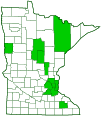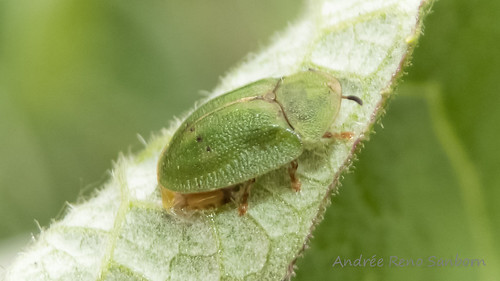thistle tortoise beetle
(Cassida rubiginosa)
Conservation • Description • Habitat • Ecology • Distribution • Taxonomy
|
|
||||||||||||||
Description |
Thistle tortoise beetle is a small, exotic beetle. It is native to Europe and Asia. It was introduced into Quebec in 1901 and has since spread across the continent. It is now common in the northern United States from Vermont south to Maryland and west to Great Lakes states. It is present but uncommon in the west. It is uncommon but increasing in Minnesota. It was introduced into New Zealand as a control of the non-native Canada thistle. Though effective, it is not used in the United States because it also attacks beneficial native thistles. Adults are tortoise-shaped, ¼″ to 5 ⁄16″ (6 to 8 mm) long, oval when viewed from above, and convex when viewed from the side. The female is larger than the male. The upper thoracic plate (pronotum) and hardened wing covers (elytra) are green. The edges are spread out, flattened, and thin, and extend over the head and legs. The front (anterior) edge of the pronotum is broadly rounded. The corners at the base of the pronotum are at right angles. The plate between the wing bases (scutellum) is small and triangular. The front margins of the elytra, when taken together, form a very shallow arc with a strong, brace-like excavation around the scutellum. The upper surface of the elytra is covered with small punctures but is not deeply pitted or wrinkled. There is a small depression on each elytron in the middle on the front margin. Each depression usually contains a small spot or dark shading. The inner margin of each elytron, where they meet (together called the suture) often has dark shading. The underside of the body is black. The head is completely concealed when viewed from above. The eyes are not notched. The antennae are long but less than half as long as the body. The first five segments are pale, the remainder dark. Segment 3 is distinctly longer than segment 2, and segment 8 is distinctly longer than wide. The antennae are extended when at rest. There is no groove on the underside of the prothorax for them to be tucked into. The third segment of the leg (femur) is black at the base, orangish-brown at the tip. The fourth segment (tibia), and the last part of leg (tarsus), corresponding to the foot, are orangish-brown. The tarsus has five segments. The fourth segment is very short and is concealed within the broadened tip of the third segment, making the tarsus appear to have only four segments. The last segment bears a pair of well-developed claws. |
Size |
Total length: ¼″ to 5 ⁄16″ |
Similar Species |
Habitat |
Weedy fields, roadsides, parks |
Ecology |
Season |
One generation per year: March through September |
Behavior |
Adults feed on the underside of leaves, larvae feed on the upperside. They eat round holes in the leaves. The larvae carry dried fecal matter over their body, presumably as a form of camouflage. The fecal matter is attached to a forked appendage on the last abdominal segment, and is held suspended over the body. |
Life Cycle |
Adults overwinter in tussocks, leaf litter, and moss. The female lays groups of eggs on the underside of leaves near the base of the plant. The eggs hatch in about a week, and the young reach maturity in about six weeks. |
Larva Food |
|
Adult Food |
Leaves of plants in the Asteraceae (Aster) family, especially thistles Carduus, Cirsium, and Onopordum, but also knapweed and burdock. |
Distribution |
||
|
Sources |
|
| 11/4/2024 | ||
Occurrence |
||
Still uncommon but increasing in Minnesota |
||
Taxonomy |
|
Order |
Coleoptera (Beetles) |
Suborder |
Polyphaga (Water, Rove, Scarab, Long-horned, Leaf, and Snout Beetles) |
Infraorder |
Cucujiformia |
Superfamily |
Chrysomeloidea (leaf beetles and allies) |
Family |
Chrysomelidae (leaf beetles) |
Subfamily |
Cassidinae (tortoise and hispine beetles) |
Tribe |
|
Genus |
Cassida (shiny tortoise beetles) |
Subordinate Taxa |
|
|
|
Synonyms |
|
|
|
Common Names |
|
green thistle beetle thistle tortoise beetle |
|
Glossary
Elytra
The hardened or leathery forewings of beetles used to protect the fragile hindwings, which are used for flying. Singular: elytron.
Femur
On insects and arachnids, the third, largest, most robust segment of the leg, coming immediately before the tibia. On humans, the thigh bone.
Pronotum
The exoskeletal plate on the upper side of the first segment of the thorax of an insect.
Scutellum
The exoskeletal plate covering the rearward (posterior) part of the middle segment of the thorax in some insects. In Coleoptera, Hemiptera, and Homoptera, the dorsal, often triangular plate behind the pronotum and between the bases of the front wings. In Diptera, the exoskeletal plate between the abdomen and the thorax.
Tarsus
On insects, the last two to five subdivisions of the leg, attached to the tibia; the foot. On spiders, the last segment of the leg. Plural: tarsi.
Tibia
The fourth segment of an insect leg, after the femur and before the tarsus (foot). The fifth segment of a spider leg or palp. Plural: tibiae.
Visitor Photos |
||
Share your photo of this insect. |
||
This button not working for you? |
||
Alfredo Colon |
||
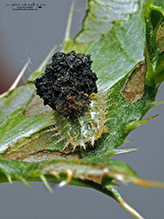 |
||
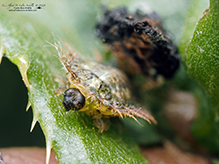 |
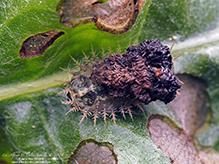 |
|
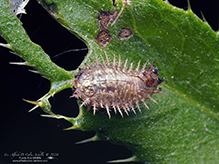 |
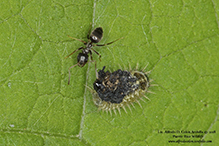 |
|
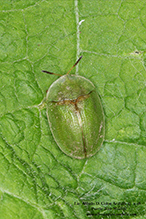 |
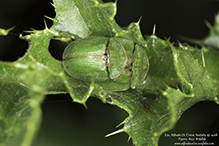 |
|
N. G. Carlson |
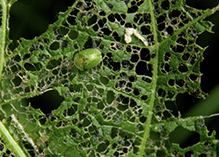 |
MinnesotaSeasons.com Photos |
||
|
||
|
||

Visitor Videos |
||
Share your video of this insect. |
||
This button not working for you? |
||
|
Other Videos |
||
Thistle Tortoise Beetle (Chrysomelidae: Cassida rubiginosa) on Leaf |
About
Published on Jun 5, 2010 Photographed at Grand Forks, North Dakota (04 June 2010). |
Cassida rubiginosa |
About
Published on Jul 16, 2017 Short little movie about the way the Thistle Tortoise Beetle moves around, how it looks underneath its "shell" and how it eats. |
Cassida Rubiginosa |
About
Published on Apr 3, 2017 |
LITTLE GREEN BUG[CASSIDA RUBIGINOSA] |
About
Published on Aug 2, 2011 THIS LITTLE GREEN BUG IS KNOWN AS [CASSIDA RUBIGINOSA]WILL I THINK THAT'S WHAT IT'S CALLED???COULD BE WRONG SOME ONE LET ME KNOW! |

Visitor Sightings |
||
Report a sighting of this insect. |
||
This button not working for you? |
||
Alfredo Colon |
Location: Albany, NY |
 |
Alfredo Colon |
Location: Albany, NY |
 |
| Alfredo Colon 8/20/2018 |
Location: Woodbury, MN |
 |
| Alfredo Colon 7/15/2018 |
Location: Woodbury, MN |
 |
| Alfredo Colon 7/12/2018 |
Location: Woodbury, MN |
 |
MinnesotaSeasons.com Sightings |
||
|

Created: 1/12/2019 Last Updated: © MinnesotaSeasons.com. All rights reserved. |
